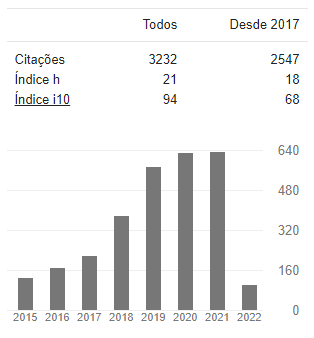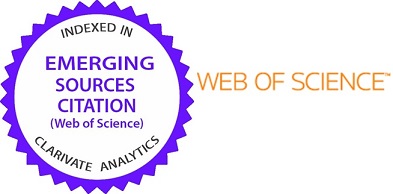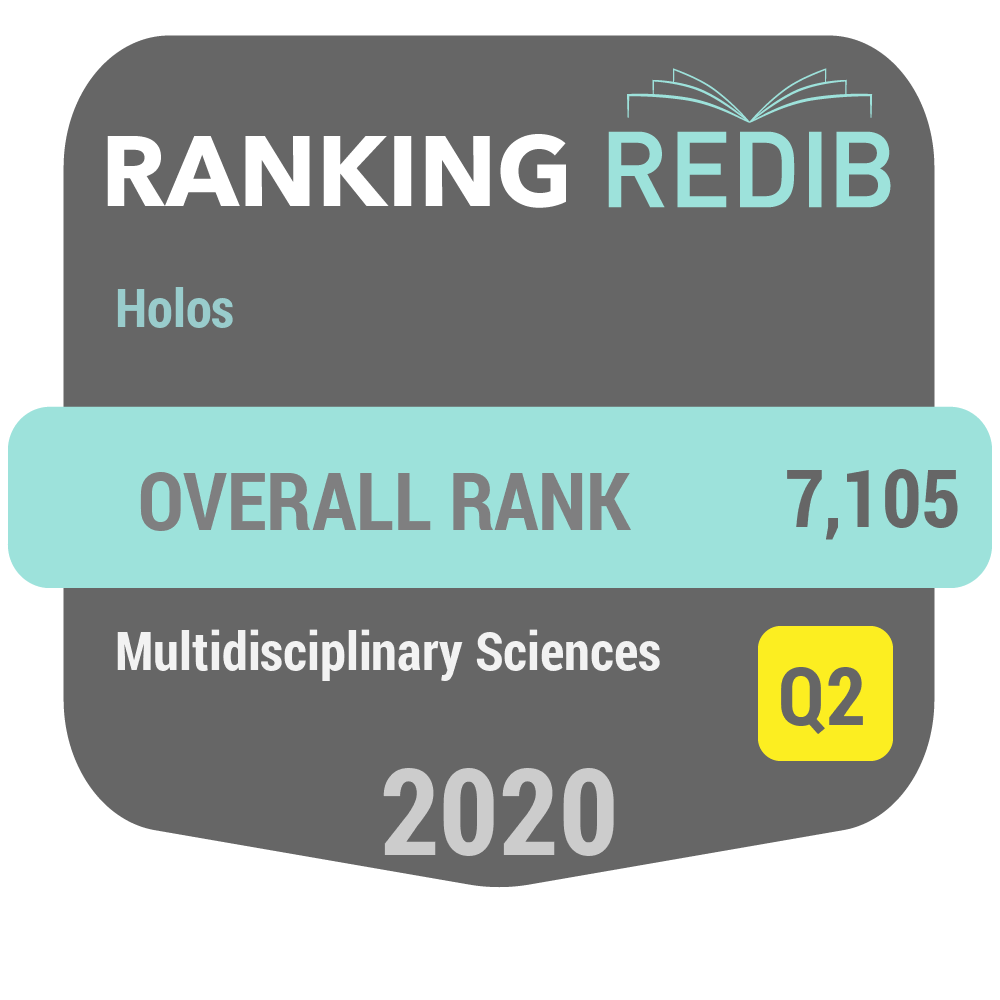IMPACTO DE FATORES METEOROLÓGICOS SOBRE AS CONCENTRAÇÕES DE OZÔNIO MODELADOS POR ANÁLISE DE SÉRIES TEMPORAIS E MÉTODOS ESTATÍSTICOS MULTIVARIADOS
DOI:
https://doi.org/10.15628/holos.2017.5033Palavras-chave:
ozônio urbano, Campo Grande, parâmetros meteorológicosResumo
O objetivo desta pesquisa foi de desenvolver um modelo para prever as concentrações de ozônio em função das variáveis climáticas. As medidas de concentração do ozônio foram realizadas na Universidade Federal de Mato Grosso do Sul, utilizando dados do período de janeiro a dezembro de 2014. As variáveis preditoras referentes ao clima (umidade relativa, velocidade do vento, chuva, aeerossóis, índice de claridade, radiação solar global e temperatura) foram cedidas pela CEMTEC-Campo Grande-MS. Foram realizadas análise de componentes principais (PCA) e análise de regressão linear múltipla (MLR) aplicadas a estas séries temporais. As principais relações observadas nestas análises foram então usadas para obter uma equação de regressão que liga as concentrações de ozônio diurnas com parâmetros climáticos. O modelo desenvolvido é capaz de explicar 99% da variabilidade nas concentrações de ozônio de superfície com um erro de 0,2%?
Downloads
Referências
Abdul-Wahab SA, Bakheit, CS, Al-Alawi SM (2005). Principal component and multiple regression analysis in modelling of ground-level ozone and factors affecting its concentrations, Environmental Modelling & Software, 20(10), 1263-1271.
Asaf, D., Mordechai, P., Jihad, A., Aiman, S., Valeri, M., Eran, T., Allan, G., Menachem, L. (2011).Trans-boundary transport of ozone from the Eastern Mediterranean Coast. Atmospheric Environment, 45(31), 5595–5601.
Ashmore, M.R. Assessing the future global impacts of ozone on vegetation. (2005). Plant Cell and Environment, 56(8): 949 – 964.
.Brasil. Resolução CONAMA no 3, de 28 de junho de 1990.Disponivel em: http://www.mma.gov.br/port/conama/legiabre.cfm?codlegi=100
Chelani, A. B., Devotta, S. (2006). Air quality forecasting using a hybrid autoregressive and nonlinear model. Atmospheric Environment, 40(10), 1774–1780.
Cheng, C.S., Campbell, M., Li, Q., Auld, H., Day, N., Pengelly, D., Gingrich, S., Yap, D. (2007). A Synoptic Climatological Approach to Assess Climatic Impact on Air Quality in South-central Canada. Water Air Soil Pollut, 182(1), 117-130.
Duan, J., Tan, J., Yang, L., Wu S.S., Hao, J. (2008). Concentration, sources and ozone formation potential of volatile organic compounds (VOCs) during ozone episode in Beijing. Atmospheric Research, 88(1), 25–35.
Hastie, D.R., Narayan, J., Schiller, C., Niki, H., Shepson, P.B., Sills, D.M.L.,Taylor, P.A. et al. (1999). Observational evidence for the impact of the lake breeze circulation on ozone concentrations in Southern Ontario. Atmospheric Environment, 33(2), 323-335.
He, J.J., Yu,Y., Xie, Y.C., Mao, H.J., Wu, L., Liu, N., Zhao, S.P. (2016). Numerical model-based artificial neural network model and its application for quantifying impact factors of urban air quality. Water, Air & Soil Pollution, 227-235.
Holben, J.S., Schafer, B.N.E., Yamasoe, T.F., Artaxo, P. (2002). Atmospheric effects on insolation in the Brazilian Amazon: Observed modification of solar radiation by clouds and smoke and derived single scattering albedo of fire aerosols. Journal of Geophysical Research, 107(D20), 8074.
Hu, J., Chen, J., Ying, Q., Zhang, H. (2016). One-Year Simulation of Ozone and Particulate Matter in China Using WRF/CMAQ Modeling System. Atmos. Chem. Phys. Discuss, 16, 1-31.
Jiang, N., Dirks, K.N., Luo, K. (2014). Effects of local, synoptic and large-scale climate conditions on daily nitrogen dioxide concentrations in Auckland, New Zealand. Int. J. Climatol., 34, 1883–1897.[
Kim, S.E. (2010). Tree-based threshold modeling for short-term forecast of daily maximum ozone level. Stochastic Environmental Research and Risk Assessment, 24(1), 19-28.
Kova?-Andri?, E., Brana, J., Gvozdi?, V. (2009). Impact of meteorological factors on ozone concentrations modelled by time series analysis and multivariate statistical methods. Ecological Informatics, 4, 117–122.
Kudish, A.I., Ianetz, A. (1992). Analysis of the solar radiation data for Beer Sheva, Israel, and its environs. Solar Energy, 48(2), 97-106.
Kumar, U., Jain, V.K. (2010). ARIMA forecasting of ambient air pollutants (O3, NO, NO2 and CO). Stochastic Environmental Research and Risk Assessment, 24(5), 751-760.
Lee, C.C., Ballinger, T.J., Domino, N.A. (2012). Utilizing Map Pattern Classification and Surface Weather Typing to Relate Climate to the Air Quality Index in Cleveland, Ohio. Atmospheric Environment, 63, 50-59.
Montogomery, D.C., Peck, E.A., Vining, G.G. (2001). Introduction to linear regression analysis. (3a ed.). New York, USA: John Wiley & Sons.
Na, K., Kil-Choo, M., Yong, P.K. (2005). Source contribution to aromatic VOC concentration and ozone formation potential in the atmosphere of Seoul. Atmospheric Environment, 39(30), 5517–5524.
Oanh, N.T.K., Chutimon, P., Ekbordin, W., Supat, W. (2005). Meteorological pattern classification and application for forecasting air pollution episode potential in a mountain-valley area. Atmospheric Environment, 39(7), 1211–1225.
Ohura, T., Amagai, T., Fusaya, M. (2006). Regional assessment of ambient volatile organic compounds in an industrial harbor area, Shizuoka, Japan. Atmospheric Environment, 40(2), 238–248.
Olsen RL, Chappell RW, Loftis JC (2012). Water quality sample collection, data treatment and results presentation for principal components analysis-literature review and Illinois River watershed case study, Water Research, 46(9), 3110-3122.
Pinto, D.M., Blande, J.D., Souza, S.R., Amnerg, J., Holopainen, K. (2010). Plant volatile organic compounds (VOCs) in ozone (O3) polluted atmospheres: the ecological effects. J Chem Ecol., 36(1), 22-34.
Pires, J.C.M., Souza, A., Pavão, H.G., Martins, F.G. (2014). Variation of surface ozone in Campo Grande, Brazil: meteorological effect analysis and prediction. Environmental Science and Pollution Research International, 21, 10550-9.
Poschl, U. (2005). Atmospheric aerosols: Composition, transformation, climate and health effects. Angewandte Chemie-International Edition, 44(46), 7520-7540.
Pui, D.Y.H., Chen S.-C., Zuo, P. (2014). "PM2.5 in China: Measurements, sources, visibility and health effects, and mitigation". Particuology, 13, 1-26.
Ricieri, R.P. (1998). Modelos de estimativa e avaliação dos métodos de medida da radiação solar difusa. 1998. 81 f. Tese de doutorado em Energia na Agricultura. Universidade Estadual Paulista, Faculdade de Ciências Agronômicas, Botucatu, SP, Brasil.
Sanchez-Ccoyllo, O.R., Ynoue, R.Y., Martins, L.D., Andrade, M.F. (2006). Impacts of ozone precursor limitation and meteorological variables on ozone concentration in São Paulo, Brazil. Atmospheric Environment., 40, S552–S562, 2006.
Souza, A., Fernandes, W.A., Albrez, E.A., Galvinio, J.D. (2012). Analise de agrupamento da precipitação e da temperature no Mato Grosso do Sul.Acta Geografica, Boa Vista, v.6, n.12, 109-124.
Souza, A., Aristones, F., Pavao, H.G., Fernandes, W.A. (2014). Development of a Short-Term Ozone Prediction Tool in Campo Grande-MS-Brazil Area Based on Meteorological Variables. Open Journal of Air Pollution, 03, 42-51.
Souza, A., Aristones, F., Goncalves, F.V. (2015). Modeling of Surface and Weather Effects Ozone Concentration Using Neural Networks in West Center of Brazil. Journal of Climatology & Weather Forecasting, 03(1), 4.
Souza, A., Aristone, F., Pavao, H.G., Kofanovski, A.Z., Santos, D.A.S. (2015). Impacto do ambiente atmosférico nas internações hospitalares por doenças respiratórias. Espacios, 36(24), 12.
Souza, A., Kova?, E., Brunislav, B., Markovi, B. (2016). Assessment of Ozone Variations and Meteorological Influences in West Center of Brazil, from 2004 to 2010. Water, Air and Soil Pollution (Print), 227, 313.
Souza, A., Pavao, H.G., Garcia, A.P. (2013). Modeling of ozone due to weather conditions. Revista Brasileira de Climatologia, 12, 7-21.
Stoeckenius, T.E., Christian, H., Justin, Z., Timothy, M.S., Benjamin, W., Tanarit, S. (2015). A comparison between 2010 and 2006 air quality and meteorological conditions, and emissions and boundary conditions used in simulations of the AQMEII-2 North American domain. Atmospheric Environment, 115, 389–403.
Sun, Y, Jiang, Q., Wang, Z., Fu, P., Li, J., Yang, T., Yin, Y. (2014). Investigation of the sources and evolution processes of severe haze pollution in Beijing in January 2013, J. Geophys. Res. Atmos., 119(7), 4380–4398.
Tamerius, J., Wise, E., Uejio, C., Mccoy, A., Comrie, A.C. (2007). Climate and Human Health: Synthesizing Environmental Complexity and Uncertainty. Stochastic Environmental Research and Risk Assessment, 21(5), 601-613.
Xu, H., Zhang, H., Xing, Z.Y., Deng, J.J. (2015). Pollution characteristics and ozone formation potential of ambient VOCs in winter and spring in Xiamen. Environmental science, 36, 11-17.
Yamasoe, M.A., Artaxo, P., Miguel, A.H., Allen, A.G. (2000). Chemical composition of aerosol particles from direct emissions of biomass burning in the Amazon Basin: water-soluble species and trace elements. Atmospheric Environment, 34, 1641-1.653.
You, X., Senthilselvan, A., Cherry, N.M., Kim, H.G., Burstyn, I. (2008). Determinants of airborne concentrations of volatile organic compounds in rural areas of Western Canada. J Expo SciEnviron Epidemiol., 18(2), 117-28.
Wang, D., Hub, J., Xua, Y., Lva, D., Xiea, X., Kleemanb, M. et al. (2014). Source contributions to primary and secondary inorganic particulate matter during a severe wintertime PM2.5 pollution episode in Xi'an, China. Atmospheric Environment, 97, 182-194.
Zheng, B., Zhang, Q., Zhang, Y., He, K.B., Wang, G.J., Zheng, F.K., Duan, Y.L., Ma, Y.L., Kimoto, T. (2015). Heterogeneous chemistry: a mechanism missing in current models to explain secondary inorganic aerosol formation during the January 2013 haze episode in North China. Atmos. Chem. Phys., 15(









































